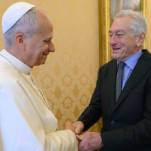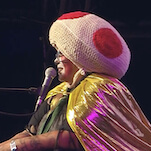We explore some of Wikipedia’s oddities in our 6,951,586-part monthly series, Wiki Wormhole.
This week’s entry: Šćepan Mali
What it’s about: A con artist who was able to take power by spreading misinformation his supporters adhered to even when it was clearly false. We’re of course talking about Šćepan Mali (“Stephen The Little” in Serbian), the only tsar in the history of Montenegro. Šćepan arrived in 1766, from parts unknown, and within a year the 27-year-old mystery man was put in charge of the country, and is to this day remembered as both a complete fraud and one of the country’s better rulers.
Biggest controversy: Šćepan managed to take the throne by dressing for the job he wanted. In 1762, Russian tsar Peter III had been deposed after only six months, by his wife, Catherine The Great, and soon after died under mysterious circumstances. When Šćepan arrived in Montenegro, rumors started bubbling up that he was in fact the tsar, living under an assumed name after faking his death. Šćepan fanned these rumors by neither confirming nor denying them, simply letting people assume he was important until he did in fact become a prominent figure in Montenegro.
He also started acting like a leader. Although he was working as a local doctor, he issued a proclamation to the nation, insisting Montenegrin clans stop feuding, embrace Orthodox values, and unite against their external foes. (While independent, the Ottoman Empire claimed authority over the principality, and Venice had been encroaching on their land as well.) The local nobility took the proclamation seriously, and agreed to pause internecine hostilities, but only for a few months. This wasn’t good enough for Šćepan, who tore up the agreement and demanded the nobles swear to stop fighting among themselves forever. So boldly making a demand of a bunch of nobles only further convinced them he was in fact royalty, and they even issued an official statement recognizing him.
Montenegro’s actual ruler, Prince-Bishop Sava, was understandably threatened by all of this. Sava was considered an “idle ruler,” and was not well-loved by Montenegrins. He got the Russian ambassador in Constantinople to declare Šćepan an impostor, but when he confronted the nobles with this evidence, they stripped Sava of his title and property, and named Šćepan Montenegro’s first tsar.
Strangest fact: Šćepan was actually good at his job. The nobility held to the truce he had brokered, ushering in an unprecedented era of peace and stability. Inspired by Montenegro’s show of unity, neighboring provinces under the Ottoman or Venetian sphere of influence stopped paying tribute. Even Montenegrins who understood that Šćepan was a fraud didn’t care, as long as he was providing more leadership than Sava had.
Abroad, however, people cared very much. Russia, Venice, and the Ottomans were all threatened by the pretender now on the throne. Any one of those countries was far more powerful than Montenegro. But they couldn’t get out of each other’s way. Catherine The Great sent emissaries to denounce Šćepan as a fraud; they couldn’t get past a Venetian blockade. The Ottomans sent an army of 50,000 soldiers; Šćepan hastily assembled a militia of 10,000 Montenegrins. The home team won the first battle, after which Russia declared war on the Ottomans and they backed off from Montenegro.
Thing we were happiest to learn: Having won over the Montenegrins, Šćepan managed to win over the Russians. Not at first, of course. Catherine tried again to expose Šćepan, this time sending one of her generals, Prince Yuri Vladimirovich Dolgorukov, who demanded (and got) a face-to-face meeting with Šćepan and the Montenegrin nobility to expose their new ruler as a fraud. Šćepan tried the old “no puppet, you’re the puppet” gambit, accusing the Russians of being impostors, but no one bought it. Prince-Bishop Sava feigned illness and stayed home to avoid any confrontation.
Dolgorukov laid out his case that Šćepan was a fraud, and insisted the nobles declare loyalty to Catherine. They agreed, but they refused to arrest Šćepan, and Dolgorukov’s own men took him into custody themselves. Upon interrogation, Šćepan admitted he was not Russian, but Greek, although this was clearly a lie, as he didn’t speak Greek. Only on threat of torture did he give his family name—Rajčevuć—and claim to be Dalmatian. There was no way to confirm this, but it was acknowledgment that he wasn’t Peter III, and that was enough.
Šćepan was imprisoned, and with Sava hiding in bed and clearly unfit to rule, that left Dolgorukov as Montenegro’s new leader. It didn’t go well. Montenegro’s clans immediately went back to infighting, even with the threat of an Ottoman invasion looming. Both the Ottomans and Venetians tried to assassinate Dolgorukov, and the Russian reinforcements he had been promised never arrived.
So, he gave up. Dolgorukov fled to the coast (Sava offered the use of his monastery, so he could spy on the general on behalf of the Venetians), and granted Šćepan a pardon, named him a Russian officer, and put him back in charge of Montenegro. While this seems on the surface to be a desperation move, it seems Šćepan had charmed the general. He personally guided Dolgorukov through the rocky coast to the monastery, and the general later recalled in his memoirs, “I would have truly fallen into the abyss had not Šćepan Mali… virtually carried me in his arms.” (History records that the two were simply very close friends.)
Thing we were unhappiest to learn: The remainder of Šćepan’s reign was successful, but short-lived. In 1771, two years after being reinstated, he was personally supervising highway construction through the mountains. He was demonstrating how to lay a mine when the charge exploded, leaving him seriously injured. (He spent the rest of his reign being carried around in a sedan chair.)
Two years later, the Ottomans, still worried Russian-allied Montenegro was a threat, bribed one of Šćepan’s servants to kill him. He was found with his throat cut, dead at age 34(-ish, you’ll be shocked to learn the biographical details on this mysterious impostor are sketchy), after five years in power.
Best link to elsewhere on Wikipedia: Upon Šćepan’s death, Prince-Bishop Sava resumed power. Oddly, his brief Wiki entry makes no mention of Šćepan or that he was deposed for five years. However, it does mention the previous time that had happened—back in 1744, after Sava had failed at securing military protection from Catherine the Great, he withdrew from public life, and his cousin Vasilije Petrović Njegoš ran Montenegro, although Sava was still credited as co-ruler. Njegoš died in 1766, and Sava was back on top for less than a year before Šćepan showed up.
Further down the Wormhole: When Catherine The Great initially heard someone was impersonating her dead husband, she was so worried an impostor might similarly infiltrate her own court she had border agents detain suspicious travelers as far away as Riga. Now Latvia’s largest city, Riga was part of the Russian Empire from 1721 until 1917, when it was ceded to Germany during WWI, albeit only briefly, as Latvia was granted independence after the war.
Riga has a long list of sister cities around the world; its American counterpart is Dallas. Texas’ third-largest city is diverse, surprisingly liberal, and mostly just an excuse for us to get to nearby Eastland, Texas, so that next month we can talk about that town’s most famous resident, Ol’ Rip The Horned Toad.








































